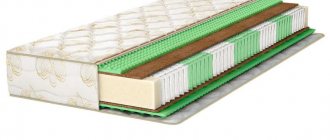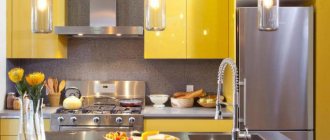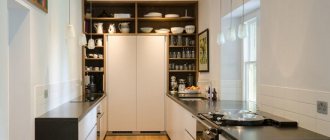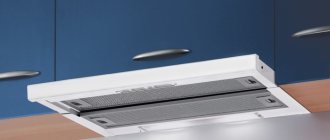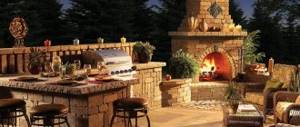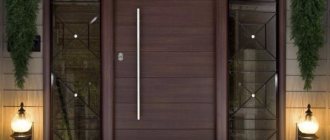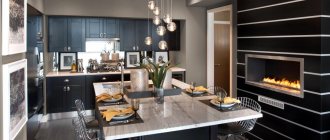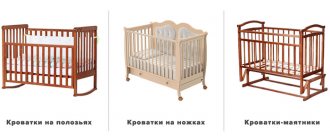The main differences between inclined models
From the name it is clear that the working plane of kitchen hoods is not horizontal in relation to the stove, but is located at an angle. Thanks to this compact design, it is more comfortable to be near the stove, as there is a “reserve” in height. And in order for the exposed air intake to look neat, designers are coming up with more and more new design options for hoods, turning them into a real decoration of the kitchen.
Among specialists, inclined or vertical hoods are also called perimeter hoods, since they suck in air through holes located along the contour of the decorative door of the portal. The principle of their operation is based on the basic laws of aerodynamics, according to which the air flow, passing a bottleneck, increases its speed. This is exactly what happens in the cracks left around the perimeter of the exhaust opening, and thanks to this acceleration, dirt does not accumulate on the edges of the door, but is sent straight to the filters.
Other advantages of inclined devices are rather due to their belonging to the latest generation exhaust systems. All the most advanced technologies and effective ideas have already been implemented here:
- Quiet mode down to barely perceptible noise;
- Convenient control methods;
- A large number of operating modes;
- High performance with lower power consumption;
- Programming and automation of work processes.
Also, inclined models are more diverse in terms of the use of materials. In addition to standard metal and plastic, structures can be made of heat-resistant glass or ceramics, painted in bright colors, and decorated with figured overlays. Some devices don’t even look like a range hood – rather, they look like a plasma TV screen or a stylish kitchen accessory.
Advantages of corner models
Corner hoods for the kitchen make the interior of the room more modern and functional. Designs of this type have a number of advantages that are definitely worth paying attention to. Among them:
- Space saving . Due to the fact that the structure is placed in a corner, it takes up minimal space and makes good use of every centimeter of space. This arrangement allows you to fit even large models in small spaces.
Thanks to their shape, such devices can fit even into a small kitchen.
- Easy to install . It is not difficult to install such a unit with your own hands - you can cope with it even without having special construction skills.
- Convenient control . The kitchen corner hood is controlled using regular buttons, a touch panel or a remote control.
Compact devices can be controlled using a touch panel, buttons or remotely
- High decorative performance . Similar models are available in different shapes and using different materials. Round and spherical models equipped with additional lighting look especially stylish.
- Price . Compared to larger models, the cost of these devices is much more affordable.
What a kitchen with a corner hood can be like: a kitchen in a classic style, hi-tech, Provence, techno or loft
Functions
Some vertical models provide for operation only in recirculation mode, that is, through filters, but without removing moist and polluted air. On the other hand, this simplifies installation and saves some more space. If it is possible to organize an air duct in the room, it is better to use inclined systems that completely clean the kitchen of smoke and food odors.
There are also combined hoods that can operate in two filtration modes. They are more expensive, but they allow you to choose the method of air purification depending on a particular type of work. For example, it is better to fry fish and cutlets with complete smoke removal, but you can cook pasta or quickly reheat a dish using the recirculation mode.
In addition to the usual on/off and fan speed selection, inclined hoods can be equipped with various additional options:
- Filter control is a particularly important function for recirculating models, the effectiveness of which directly depends on the condition of the cartridges.
- Automatic mode switching - the hood itself will determine at what power level it needs to work, when it should turn on or off.
- Timer operation – allows you to set a program that the equipment will execute.
In the case where the kitchen is an extension of a large room, for example, a living room or dining room, it makes sense to purchase an inclined hood with a remote control.
Selection rules
Since the main purpose of exhaust equipment is to promptly and completely remove “dirty” air from the cooking zone, it is primarily required to have appropriate performance. To determine it, it is enough to multiply the kitchen area by the height and by two constant coefficients: 12 and 1.3. The result is the main characteristics of the hood that are optimal for your home.
Despite the compact size of inclined models, their dimensions must be clearly selected in accordance with the characteristics of the kitchen itself. Here several conditions must be met simultaneously:
- The height of the lower edge of the hood should be at least 55 cm from the gas stove, and at least 40 cm from the electric stove.
- It is advisable to position models with outlets so that the outlet is above the level of the wall cabinets - this will allow the chimney to be laid unnoticed and with a minimum number of bends.
- The length of the vertical outlets themselves should be correlated with the height of the ceilings and the location of the exhaust panel on the wall.
Once you have decided on the basic parameters of the equipment, the desired functionality and the available way of working, you will definitely not go wrong with your choice. The appearance of the hood will depend only on the style of interior design. Inclined panels attract more attention than classic domed models, so the selection of colors and materials is an important step.
Island kitchen hood: how to choose the best option
The algorithm of actions proposed in this section will help you not to miss important points and characteristics and choose the most suitable option for an island hood.
- Initially, it is necessary to determine what type of operation the unit is needed - recirculation or flow-through. It should be based on the technical conditions of the room.
- Next, you will need to take measurements of the gas surface and compare it with the dimensions of the hood.
- Calculate the required power.
- Select control type: push-button, touch, remote, slider, electronic. It is worth remembering that models with rectangular umbrella and dome parts can have two control panels, while an island round hood can have only one.
- Determine the noise limit (above 50 dB is not recommended).
- Outline the desired additional functions: timer, filter contamination indicator, sensor providing protective shutdown, backlight, etc.
- Browse the models offered on the Internet, go to the store, having an idea of the design of the hood. Among the huge number of proposals, there is sure to be a model that suits all parameters.
A properly selected hood will solve three problems at once: it will decorate the interior, purify the air and illuminate the hob. For this to happen, you should know everything about possible models and the features of their functioning. Better yet, try and listen to the technology in action. And then not a single, even the most highly professional, manager will impose his opinion. And your own perception will be based on certain knowledge, and not just on visualization and taste.
The post Island hood: models from classic to exclusive appeared first on Remoo.RU.
https://remoo.ru/ventilyaciya/ostrovnaya-vytyazhka
Share the news on social networks
- Related Posts
- How to choose and lay paving slabs?
- Which walk-behind tractor is better: prices, reviews and characteristics of this type of equipment
- Photos of entrance doors to a private house made of various materials
« Previous entry
Review of popular models
Krona Simona-600
One of the quietest series of the Italian brand, producing about 44 dB, although its productivity is above average (900 m3/h). The design provides touch control, 3 speed modes, a grease trap contamination indicator and a pair of halogen lamps. There are simply no bad reviews about it - the equipment is really high quality and easy to use. However, housewives are talking about this inclined model, which turns on the filter indication even when it is slightly dirty. The cost is about 36 thousand rubles.
Zorg Fabia
Zorg Technology offers a solution that is cheaper and at the same time much more effective. The Fabia model, with the same width of 60 cm, has a capacity of 1000 m3/h and 5 operating modes. But its noise level is noticeably lower - only 34.5 dB. Black metal against the background of a milky-white decorative screen gives the inclined hood an original look. All this splendor costs 33 thousand rubles.
Gorenje DVG 65W
The hood, which has earned rave reviews from its owners, impresses not only with its stylish white design, but also with its very quiet operation and a very serious productivity of 720 m3/h. At the first speed it is practically silent, its sound becomes audible at the third, and only at the maximum it reaches 66 dB. An excellent combined model with touch control for owners of kitchens with an area of 20-25 m2. Price – 27,500 rub.
Pyramida BT-600
The popular and almost “folk” brand Pyramida was one of the first to enter the market of affordable equipment with its inclined hoods. The BT-600 model turned out to be very easy to use and therefore included in our review. Its main difference from many more famous systems is the non-standard design of the door, behind which the filters are hidden:
- It is completely independent and opens without any effort with a simple press.
- There is no need to hold it with your hand during maintenance - there are special stops for this.
- In the working position, the door is recessed into the housing, barely protruding beyond its plane.
Pyramida BT-600, thanks to the built-in motor with a double impeller, has a good performance of 850 m3/h. Quite quiet - at the maximum third speed it produces a sound no louder than 49 dB. The only weak point that owners note in their reviews is the poor placement of the backlight. The hood body itself prevents full illumination of the hob. Price – about 15 thousand rubles.
The future clearly belongs to wall-mounted vertical exhaust systems. They are no longer inferior to bulky umbrellas of dome models, superior to them in ergonomics and appearance.
We just have to wait until the price of new equipment reaches an acceptable level, and inclined hoods will displace the snarling “monsters” of the first generation from our kitchens.
Differences between dome and inclined hoods
The main differences between these two types of models are:
The dome version can operate in flow and recirculation mode. They are mainly produced in combination type.
The inclined option often does not require an air duct or connection to it. The dimensions of the hood are more compact.
Other differences:
Installation. The dome structure is mounted directly on the ceiling or wall. Inclined - on the surface of the wall near the slab. Installation is simpler than the first model.
Noise level emitted by fans and motor. Dome ones are much quieter than flat ones. The indicators for the first are 20-70 dB, for the second – 30-90.
Filters. The dome type is often equipped with one (grease catcher), and its replacement is not required. Flat - two (fat and coal).
Power. For a domed one it is 1000 m3/h, for an inclined one it is a maximum of 500 m3/h.
Care. The differences here lie in the type of filters: with a dome grease trap you need to wash it periodically, with an inclined filter you need to change the carbon filter twice a year.
Which model is better? For kitchens that have a large area and are equipped with a gas stove, it is preferable to buy a dome model; for a small kitchen with an electric stove, it is preferable to buy an inclined one.
